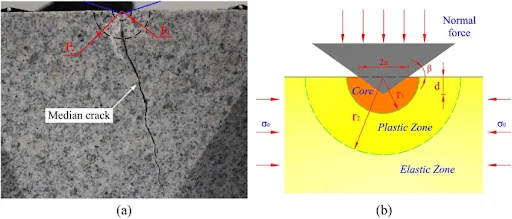rock failure theories
Rock failure theories:
Rock failure can occur due to various factors and can be explained by several theories. Here are some of the commonly accepted theories of rock failure:
1. Mohr-Coulomb Theory: This theory is widely used to understand the failure of rocks under different stress conditions. It is based on the concept of shear strength and assumes that failure occurs when the shear stress exceeds the shear strength of the rock material. The Mohr-Coulomb theory considers the cohesive strength and frictional strength of rocks in determining failure.
2. Griffith Theory: This theory, also known as the linear elastic fracture mechanics theory, focuses on the failure of rocks due to the presence of pre-existing cracks or flaws. It suggests that failure occurs when the stress intensity factor at the tip of a crack exceeds a critical value. The theory considers the elastic properties of the rock material and the size and shape of the crack.
3. Hoek-Brown Failure Criterion: Developed by Evert Hoek and John W. Brown, this theory is widely used in rock engineering and geotechnical applications. It combines the Mohr-Coulomb theory with empirical relationships to account for the effect of rock mass conditions on failure. The Hoek-Brown criterion considers the rock's strength parameters, the state of stress, and the presence of discontinuities within the rock mass.
4. Barton-Bandis Criterion: This criterion, proposed by Nick Barton and Susan Bandis, focuses on the failure of rocks with discontinuities such as joints and fractures. It considers the combined effect of intact rock strength and the shear strength of the discontinuities. The criterion incorporates parameters such as joint roughness, joint wall compressive strength, and joint wall dilation angle to assess rock failure.
5. Modified Cam-Clay Model: Although primarily used in soil mechanics, the Modified Cam-Clay model has also been adapted to analyze the failure of weak or heavily weathered rocks. It considers the nonlinear behavior of rock materials and their volume change characteristics under different stress conditions. The model incorporates parameters such as the pre-consolidation pressure and the undrained shear strength of the rock.
These theories provide valuable insights into the mechanisms of rock failure and are used to assess the stability of rock structures, design rock excavations, and plan geotechnical engineering projects. It's important to note that the selection of an appropriate theory depends on the specific geological conditions and the nature of the rock mass being analyzed.





Post a Comment